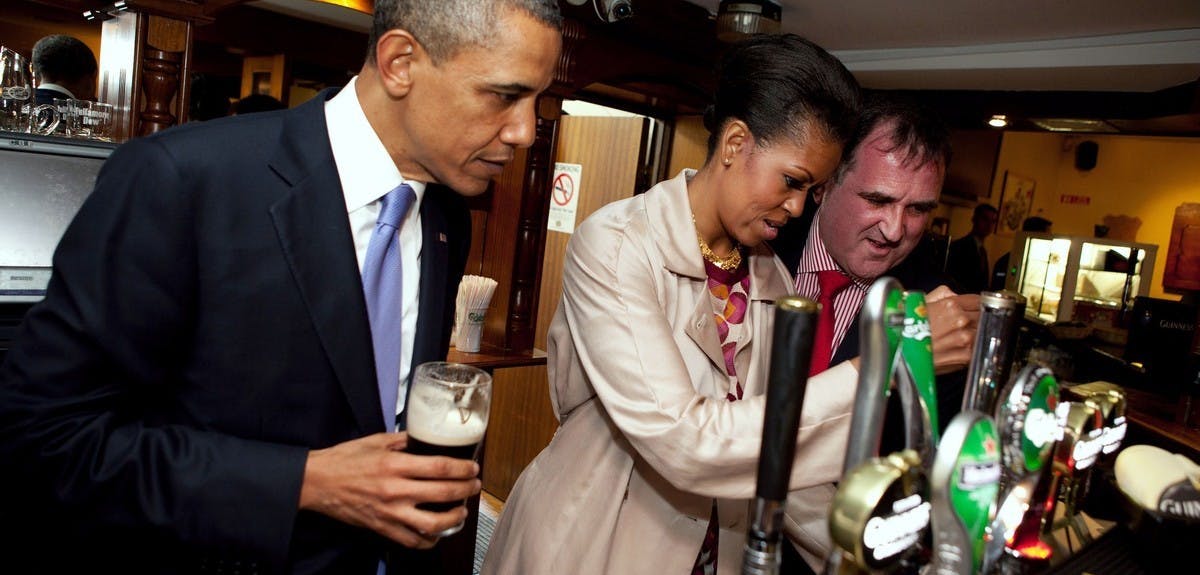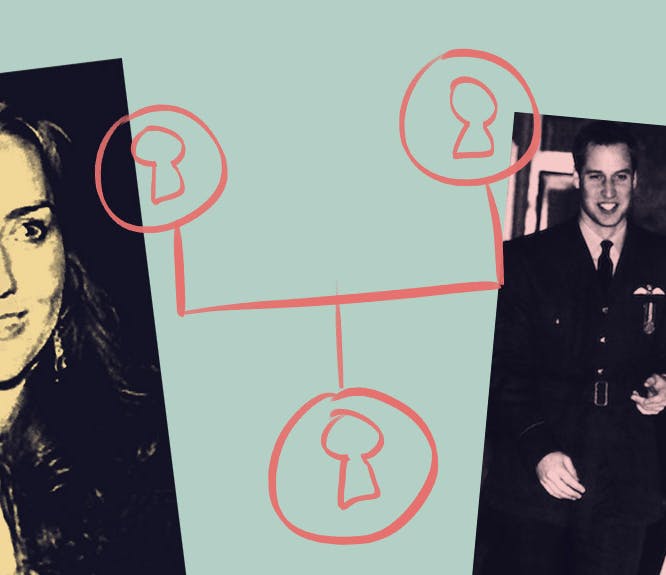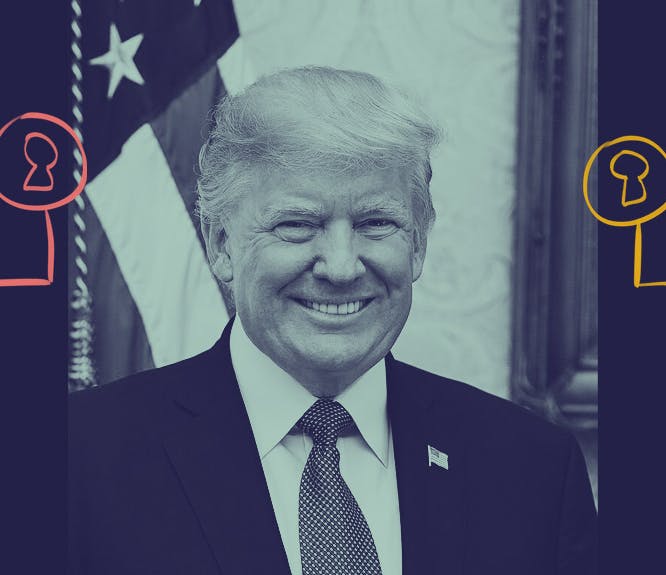Barack Obama's Irish family tree
6-7 minute read
By The Findmypast Team | February 26, 2020

Eneclann researchers from Trinity College Dublin and Irish Origins, now part of the Findmypast family, have traced Obama's family history much further back than ever before. Obama's earliest known relative, his 6th great grandfather, was a member of a family of wealthy wig makers who included an Irish politician, Michael Kearney. It was said that 'no man alive was equally fired with ambition'.
Much more is now known about Barack Obama's Irish ancestry. His 18th century Irish family were already politically active and ambitious. Our researchers have traced his family back to the 17th century, and uncovered a mass of detail about his Irish forebears. The family were prominent in the business and political life of Dublin City in the first half of the 18th Century. The head of the family, Michael Kearney was Dublin's most successful wigmaker, and even his opponents said of him, "No man alive was equally fired with ambition" in a scurrillous pamphlet in which he was accused of trying to take over the Guild of Barber Surgeons & Periwig Makers in Dublin. The pamphlet further urged the "Black-guards of Town" to pelt him Michael Kearney". The Kearneys invested their profits from wigs, in property, as the city of Dublin grew rapidly in the 1700s. If fashions had not changed, Obama might not be here: the wig market declined at the same time that the Irish economy weakened, and eventually the family emigrated to the US.
We were able to trace back Obama's irish roots from a reference in our records to a property occupied by his great-great-great-grandmother in 1851.
Barack Obama's Irish links to the Kearney family from Moneygall Co. Offaly came to light. Apart from the obvious interest of a link to a US presidential candidate, the story of the Kearney family of Moneygal ls fascinating in itself.
Our starting point was where we found Falmouth's mother, Phoebe Kearney in Griffith's Valuation.
The Kearney family history, as researched by Eneclann, is interesting, because it illustrates over five generations a family history that was not untypical in Ireland, but which we don't often consider as a typical emigrant story.
- The Kearney family were probably Gaelic Irish in origin, based on the family name, and the probable place of origin is Tipperary.
- They were skilled artisans, who prospered in the 18th Century. One branch of the family did extremely well; Michael Kearney, (Obama's 6th great-granduncle) becomes involved in the Dublin city politics of the day and John Kearney, who would be a distant cousin of Obama's, went on to become the Provost of Trinity College Dublin and later Bishop of Ossory.
- As the 19th Century progresses, the family fortunes declined in line with the country's economy, and Obama's direct family line emigrated to the US at the end of the Famine in 1851.
Phoebe Carney (= Kearney)
Wife of Joseph Kearney of Moneygall, Obama's direct 3rd great-grandfather.
Her maiden name was Donovan, and it is through her extended family the Donovans and the Benns, that the Christian name 'Falmouth' comes.
Up to now, what was in the public domain brought us back to Falmouth Kearney, Obama's 2nd great-grandfather. Through extensive research, Eneclann has taken the Kearney family tree back to Obama's 6th great-grandfather, Joseph Kearney born ca. 1698. We also traced close kinship, probably a brother, with the family of Michael Kearney, peruke maker, in Dublin.
Discover more: Boris Johnson's family tree and his royal connection to David Cameron
The Kearneys were involved in the trade of peruke or periwig making. People wore wigs in the same way that we wear business suits nowadays; in the 1700s wigs were part of the business and professional dress-code. They were also worn as luxury items by the very rich and by aristocrats. The Kearney family kept a premises at Castle Street in Dublin City, next to Dublin Castle, the seat of the political establishment in Ireland.
If we look at the Kearney family that settled in Shinrone, Co. Offaly from the 1740s onwards, Obama's direct line - Joseph Kearney, from whom Obama is directly descended, was born ca. 1698 and had four known sons:
Thomas b. ca. 1725; Joseph born ca. 1730 this is Obama's direct line.
Of these sons, Thomas followed in the profitable line of business established by the senior branch of the family, and he became a peruke-maker from the 1768 Lease
Joseph became a comber i.e. textiles/ weaving 1761 Marriage License Bond, Diocese of Killaloe
We also found within the extended Kearney family an early involvement in politics. Michael Kearney kinsman, (probably older brother) of Joseph Kearney, entered the Guild of Barber Surgeons & Periwigmakers in 1717, and was entered as a 'Capillamentarius', i.e. a hair dresser in the Freemen Rolls in 1718.
As a 'Freeman of Dublin City', he had the right to practise his trade and conduct business in Dublin City, and he had a vote in elections for the city council. Records for the Guild of Barber Surgeons & Periwig Makers, are held in Trinity College Library, Manuscripts Dept.
Michael Kearney was very active within the politics of his trade guild. In 1720, within three years of joining, he was elected house warden. In 1724, he was openly critical of the master and warden of his guild, and led a petition against them. Although he was suspended at that time, clearly he had the support of his fellow guild members. In 1726 Michael Kearney was elected master of the Guild of Barber Surgeons. We even found the number of votes for each candidate in the records in Trinity College. The voting was Michael Kearney 44 votes; Mr. Cauliff 5 votes; Mr. Wetherall 2 votes.
The Guild Minute Books also alerted us to a pamphlet written against Michael Kearney in 1726, shortly after his election as Master of his Guild. We found a copy of this pamphlet in Special Collections in the Trinity College Library. The 1726 pamphlet "Hue and Cry" is written in fairly typical 18th century political invective, it was written or commissioned by Kearney's defeated political rival(s). The pamphlet is scurrilous, scabrous and slanderous, and it should not be taken literally, this was the age of Swift when political satirists tried to out-do each other in wild exaggeration .
If we want a clear idea of what Michael Kearney's own contemporaries thought of him as a politician, we can find it in a book published in 1751, The Political Constitutions of Great Britain and Ireland, author Charles Lucas. Lucas openly criticized the political establishment of trying to rig (manipulate) elections to Dublin City Council to put in their own candidates. Although Lucas mentioned Michael Kearney in his book as prominent in the business and political life of the city, he clearly did not include Kearney in the list of the corrupt politicians of the day.
Michael Kearney remained prominent in the Guild of Barber Surgeons until his death in 1762.
Barack Obama is directly descended from the Kearneys of Shinrone & Moneygall Co. Offaly. The height of this family's prosperity was between the 1760s and 1780s, when the nephews from Offaly stepped into their Dublin uncle's business of wig-making. From the 1780s, the fortunes of this line of the Kearney family went into fairly rapid decline.
What might have caused this decline?
- Changes in fashion: by the early 19th Century, the fashion was to wear more natural styles, and the style was to decorate and dress their own hair rather than wearing an ornamental wig. Wigs were reserved for the legal profession.
- The Act of Union 1801 created the United Kingdom of Great Britain and Ireland, and abolished the Irish parliament, so that MPs elected in Ireland now sat in Westminster. The political establishment moved out of Dublin to London, and as they did so, they kept town houses in London during the sitting of Parliament. The market for wigs would have been predominantly among this elite, who suddenly vanished from Dublin.
- The very success of the Dublin Kearneys - Michael Kearney (d. 1762) - invested his profits in property in Tipperary / Offaly, and in the expanding city of Dublin. His investments did very well, and provided good dowries for his daughters and a university education for his sons, who were trained for the higher professions. John Kearney (son of Michael Kearney, bap. 1741 St Andrews CoI [Episcopalian church], Dublin) was provost of Trinity College Dublin from 1798 to 1806 when he resigned to take up the position of Bishop of Ossory. His portrait is now hanging in Trinity College in Dublin, and he's not wearing a wig!
In the next generation, the Dublin Kearneys were not involved in business. So over a generation, the extended Kearney family stopped acting as the 'Kearney corporation'. As one generation succeeded the previous one, the passage of time undermined the family connections between the Kearneys of Shinrone / Moneygall and the Kearneys of Dublin . Effectively once the family no longer had a common goal that they all worked towards, one branch of the Kearneys prospered, but the family fortunes of the other branch went into a slow decline during the 19th Century, along with the Irish economy.
Tracing the history of the Moneygall / Shinrone Kearneys, in the following generations William (1762-1828) and his son Joseph (ca. 1794-1861) both became shoe-makers, and there's no evidence to suggest that they continued to transport their goods to Dublin for sale. In other words they were shoe-makers for a rural district, where the nearest market town was Roscrea. They did however retain some property rights in Moneygall and Shinrone, as a direct consequence of the family's prosperity in an earlier generation. In fact Joseph Kearney only appears to have sold/released his rights to property in Moneygall, in 1851 LEC sale document, 'In the matter of the Estate of the Rev. William Minchin', 27 Nov. 1851.
Related articles recommended for you

Who Do You Think You Are? Series 21: here's what you missed
Discoveries

Labourers and landed gentry: Kate Middleton’s family tree
Discoveries

We discovered German and Scottish roots in Donald Trump's family tree
What's New?

